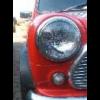
Water pump pulleys
#1

Posted 21 June 2007 - 08:23 AM
#2

Posted 21 June 2007 - 12:07 PM
I think I recall reading that the pump is most effective at around 2000rpm so start winding it up to 6-7000rpm and it just thrashes the water and doesnt actually pump very well (more tech term for thrahsing is cavitation)
#3

Posted 21 June 2007 - 12:22 PM
#4

Posted 21 June 2007 - 12:32 PM
#5

Posted 21 June 2007 - 12:37 PM
Only be worth fitting a large pulley to save HP on a track racer really.
#6

Posted 21 June 2007 - 12:41 PM
#7

Posted 21 June 2007 - 01:06 PM
The size of the pulley has nothing to do with the size of the engine or the car it came from, and the speed of the fan is only the secondary effect of the pulley size. The most important thing, as stated above it the speed of the water pump.
The original pulley was 3 7/8" diameter and was fitted to all A series engines, regardless of size. When the A+ design was being developed it was discovered that this pulley size runs the pump too fast. So fast in fact that the coolant cavitates around the impeller at higher engine speeds. That means that the pump is just thrashing the water about and chopping it up, producing voids in the coolant. that massively reduces the coolant flow. So to slow down the pump slightly the A+ engines used a 4 3/4" pulley. This does slow the fan down too obviously but to say that running the fan faster would improve rad cooling isn't strictly true. Fans work in a certain speed range for the same reason the pump impeller does. One blade causes turbulence to the blade following it and if they follow too rapidly they work less efficiently.
Generally, the larger pulley works better especially with the large impeller pump and that's why the small one has been out of production for so long. AFAIK nobody even makes an aftermarket small pulley. Which is a shame because the large pulley won't fit a small bore engine using an A series head (such as the 12G202, 206 or 295). When the large pulley was introduced to the A+ the thermostat housing section of the head was relieved a little to allow clearance for the pulley. A series heads don't have this feature so the large pulley doesn't fit beneath them on the small bore engine. So if the engine you are building is a small block A series or a small block with an A series head, use the small pulley. In all other cases use the large. And always use a large impeller pump.
#8

Posted 21 June 2007 - 09:03 PM
#9

Posted 09 September 2007 - 05:43 PM
There's a lot of half truths there so I'll clear a couple up.
The size of the pulley has nothing to do with the size of the engine or the car it came from, and the speed of the fan is only the secondary effect of the pulley size. The most important thing, as stated above it the speed of the water pump.
The original pulley was 3 7/8" diameter and was fitted to all A series engines, regardless of size. When the A+ design was being developed it was discovered that this pulley size runs the pump too fast. So fast in fact that the coolant cavitates around the impeller at higher engine speeds. That means that the pump is just thrashing the water about and chopping it up, producing voids in the coolant. that massively reduces the coolant flow. So to slow down the pump slightly the A+ engines used a 4 3/4" pulley. This does slow the fan down too obviously but to say that running the fan faster would improve rad cooling isn't strictly true. Fans work in a certain speed range for the same reason the pump impeller does. One blade causes turbulence to the blade following it and if they follow too rapidly they work less efficiently.
Generally, the larger pulley works better especially with the large impeller pump and that's why the small one has been out of production for so long. AFAIK nobody even makes an aftermarket small pulley. Which is a shame because the large pulley won't fit a small bore engine using an A series head (such as the 12G202, 206 or 295). When the large pulley was introduced to the A+ the thermostat housing section of the head was relieved a little to allow clearance for the pulley. A series heads don't have this feature so the large pulley doesn't fit beneath them on the small bore engine. So if the engine you are building is a small block A series or a small block with an A series head, use the small pulley. In all other cases use the large. And always use a large impeller pump.
Can visual inspection of a water pump (impellor and body) determine if it pumps okay. I have a 4 year old remfg pump that I suspect is causing some overheating problems. If the body or impellor have lost a little "new look smoothness" can the same cavitation effect occur?
#10

Posted 26 September 2020 - 09:48 PM
There's a lot of half truths there so I'll clear a couple up.
The size of the pulley has nothing to do with the size of the engine or the car it came from, and the speed of the fan is only the secondary effect of the pulley size. The most important thing, as stated above it the speed of the water pump.
The original pulley was 3 7/8" diameter and was fitted to all A series engines, regardless of size. When the A+ design was being developed it was discovered that this pulley size runs the pump too fast. So fast in fact that the coolant cavitates around the impeller at higher engine speeds. That means that the pump is just thrashing the water about and chopping it up, producing voids in the coolant. that massively reduces the coolant flow. So to slow down the pump slightly the A+ engines used a 4 3/4" pulley. This does slow the fan down too obviously but to say that running the fan faster would improve rad cooling isn't strictly true. Fans work in a certain speed range for the same reason the pump impeller does. One blade causes turbulence to the blade following it and if they follow too rapidly they work less efficiently.
Generally, the larger pulley works better especially with the large impeller pump and that's why the small one has been out of production for so long. AFAIK nobody even makes an aftermarket small pulley. Which is a shame because the large pulley won't fit a small bore engine using an A series head (such as the 12G202, 206 or 295). When the large pulley was introduced to the A+ the thermostat housing section of the head was relieved a little to allow clearance for the pulley. A series heads don't have this feature so the large pulley doesn't fit beneath them on the small bore engine. So if the engine you are building is a small block A series or a small block with an A series head, use the small pulley. In all other cases use the large. And always use a large impeller pump.
Great answer. Congrats!
#11

Posted 26 September 2020 - 10:10 PM
#12

Posted 27 September 2020 - 06:17 AM
https://www.speciali...ump-pulley.html
Edited by kit352, 27 September 2020 - 06:18 AM.
#13

Posted 27 September 2020 - 09:12 AM
New small pulleys are available now.
for example DSN do one.
https://www.dsnclass...trosport-small/
The new ones are beautiful. Advantage? Lighter and they will never rust.
#14

Posted 27 September 2020 - 09:18 AM
Regards
#15

Posted 27 September 2020 - 10:07 AM
I run the MED 4.2" pulley and can only just get the belt in between the pulley and head.
Attached Files
Edited by imack, 27 September 2020 - 10:11 AM.
1 user(s) are reading this topic
0 members, 1 guests, 0 anonymous users



















